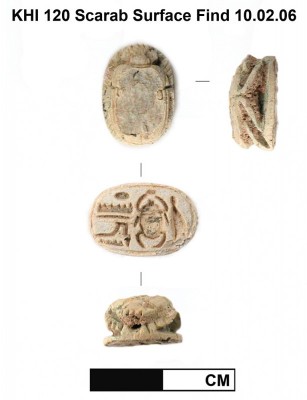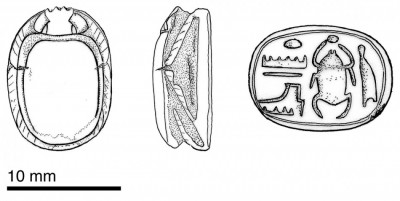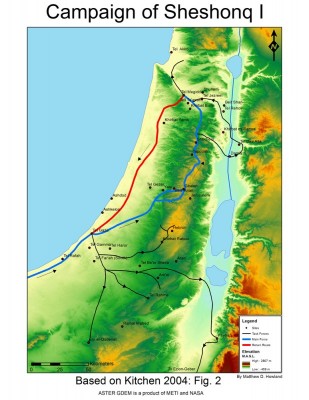A newly discovered scarab of Sheshonq I: recent Iron Age explorations in southern Jordan
Introduction
As part of a ‘deep-time’ study of the role of ancient mining and metallurgy in the copper-ore-rich region of Faynan in southern Jordan, large-scale excavations and surveys have been carried out along the major wadis of this arid zone, some 50km south of the Dead Sea and 25km north-west of Petra. Beginning in 2002, the Edom Lowlands Regional Archaeology Project (ELRAP) of UC San Diego and the Department of Antiquities of Jordan focused investigations on the social dynamics of copper production during the Iron Age (c. 1200–500 BC), when the first industrial scale copper production began in this region (Pyatt et al. 1999; Hauptmann 2007). After more than 10 years of fieldwork, the final project monograph has now been published (Levy et al. 2014a) summarising excavations at Khirbat en-Nahas (the largest copper production site in the region), the Wadi Fidan 40 cemetery, test soundings at a wide range of sites, and intensive pedestrian surveys along major drainages in the area (Wadi Fidan, Wadi Jariyah, Wadi Guwayba, Wadi Feid and others). Here we report on the accidental discovery of an extremely rare epigraphic find: a small Egyptian scarab bearing the name of the Pharaoh Sheshonq I, who is the only historical figure known from both the Hebrew Bible (as Shishak) and Egyptian monuments indirectly linked to narratives concerning King Solomon (I Kings 9.15–19). To date, the only other southern Levantine epigraphic artefact bearing the name of Sheshonq I was a stela fragment left in a dump at Megiddo by the Schumacher excavations and found by University of Chicago excavators in 1925 when they were constructing their dig house. The new Jordanian discovery adds an important data point for identifying the route of Sheshonq I's Asiatic campaign.
The scarab (Figure 1)
The scarab was found at the site of Khirbat Hamra Ifdan (30.661394N/35.392700E), located along the Wadi Fidan, at the ‘gateway’ to the Faynan district. The site is primarily a copper manufactory dating to the Early Bronze Age, c. 3000–2000 BC (Levy et al. 2002). It features also a caravanserai from the Classical and Islamic periods and, most importantly, there are areas of copper smelting that date to the Iron Age IIA period, c. 980–830 BC. Unfortunately, the scarab reported here was a surface find and therefore, like the Sheshonq I stela found at Megiddo, not in situ.
The scarab is made of enstatite. It is light brown in colour with traces of green glaze in the recesses. Its dimensions are 12.7mm long × 9.2mm wide × 5.5mm high. The plinth at the base is horizontally arranged and bordered by a thin line. The enclosed hieroglyphs read (from right to left): ḥḏt (S1) and ḫpr (L1) with a small r‘ (N5) between the scarab beetle’s forelegs, followed to the left by stp (U21) atop an n (N35); above these two signs are again an r‘, a mn (Y5) and a second n (Figure 2).
Implications
The hieroglyphic sequence reads ‘bright is the manifestation of Re, chosen of Amun/Re’ which corresponds with great certainty to the throne name of the founder of the Twenty-second Egyptian Dynasty, Sheshonq I (946/45–925/24 BC (cf. von Beckerath 1997: 191; see also Shortland 2005)). After the well-known stela found at Megiddo (Fischer 1929: 12–16; Kitchen 1986: 299; Schipper 1999: 129–32; Ritner 2009: 218–19), this is only the second epigraphic attestation of Pharaoh Sheshonq I ever discovered in Cis- and Transjordan. An in-depth study of the parallels to this scarab is published in the UC San Diego–Department of Antiquities of Jordan monograph noted above (Levy et al. 2014a). This research suggests a production date for the scarab during the reign of Sheshonq I.
A radiocarbon date from the 2000 excavations in Area L at the site of Khirbat Hamra Ifdan confirms that Iron Age copper production activities took place at the site (2910±41 BP: 1192–1021 BC (68.2% probability) or 1261–995 BC (95.4% probability)) (Levy et al. 2012: 207–208), as do the technological artefacts found at the site. In an earlier publication, Levy et al. (2008) suggested that the disruption of copper production at Khirbat en-Nahas observed in the slag mound in Area M (see Levy et al. 2014b) may be attributed to the military activities of Sheshonq I’s army during their campaign in the southern Levant. This conclusion is based on the stratigraphy, high precision radiocarbon dating and a small assemblage of Egyptian amulets dating to the time of Sheshonq I. The scarab from Khirbat Hamra Ifdan contributes to understanding of what Kenneth Kitchen (2003: 296) describes as the “flying column” of Sheshonq I’s forces during their Asiatic campaign when they made their way across the northern Negev, to the southern end of the Dead Sea and then south through the Wadi Arabah. Figure 3 highlights this route which, no doubt, passed through the Faynan region. As suggested by the data concerning the late tenth century BC interruption of industrial-scale copper production at Khirbat en-Nahas, Sheshonq I’s forces aimed to disrupt this local industrial activity. Not only did they attack the main copper production centre at Khirbat en-Nahas, but also those in secondary production areas in Faynan such as Khirbat Hamra Ifdan reported here. The discovery of the Sheshonq I scarab in Jordan’s Faynan copper ore resource zone raises new research questions concerning the geopolitical aims of the Twenty-second Dynasty’s campaign in the southern Levant as well as the nature of the rapid technological changes observed in the archaeometallurgical record during the tenth to ninth centuries BC.
Acknowledgements
Special thanks to Ben Volta, the UC San Diego graduate student, who discovered the scarab presented here. Many thanks to Ulrike Zurkinden for drawing the scarab described in this paper. Thanks to Matt Howland for producing the map of the Sheshonq I campaign. We are especially grateful to the late Fawwaz al-Karaysheh and Monther Jamhawi, Directors General of the Department of Antiquities of Jordan, and Barbara Porter, Director of the American Center of Oriental Research (ACOR) in Amman for their logistical support.
References
- CHAPMAN, R.L., III. 2009. Putting Sheshonq I in his place. Palestine Exploration Quarterly 141: 4–17.
- FISCHER, C.S. 1929. The excavation of Armageddon (Oriental Institute Communications 4). Chicago (IL): Chicago University Press.
- HAUPTMANN, A. 2007. The archaeo-metallurgy of copper: evidence from Faynan, Jordan. New York: Springer.
- KITCHEN, K.A. 1986. The Third Intermediate period in Egypt (1100–650 BC). Warminster: Aris & Phillips.
– 2003. On the reliability of the Old Testament. Grand Rapids (MI): Eerdmans.
– 2004. The Third Intermediate period in Egypt. Oxford: Aris & Phillips. - LEVY, T.E., R.B. ADAMS, A. HAUPTMANN, M. PRANGE, S. SCHMITT-STRECKER & M. NAJJAR. 2002. Early Bronze Age metallurgy: a newly discovered copper manufactory in southern Jordan. Antiquity 76: 425–37.
- LEVY, T.E., T. HIGHAM, C. BRONK RAMSEY, N.G. SMITH, E. BEN-YOSEF, M. ROBINSON, S. MÜNGER, K. KNABB, J.P. SCHULZE, M. NAJJAR & L. TAUXE. 2008. High-precision radiocarbon dating and historical biblical archaeology in southern Jordan. Proceedings of the National Academy of Sciences 105: 16460–65.
- LEVY, T.E., E. BEN-YOSEF & M. NAJJAR. 2012. New perspectives on Iron Age copper production and society in the Faynan region, Jordan, in V. Kassianidou & G. Papasavvas (ed.) Eastern Mediterranean metallurgy and metalwork in the 2nd millennium BC: 197–214. Oxford: Oxbow.
- LEVY, T.E., M. NAJJAR & E. BEN-YOSEF. 2014a. New insights into the Iron Age archaeology of Edom, southern Jordan—surveys, excavations and research from the Edom Lowlands Regional Archaeology Project (ELRAP). Los Angeles (CA): Cotsen Institute of Archaeology Press.
- LEVY, T.E., M. NAJJAR, T. HIGHAM, Y. ARBEL, A. MUNIZ, E. BEN-YOSEF, N.G. SMITH, M. BEHEREC, A.D. GIDDING, I.W.N. JONES, D. FRESES & M. ROBINSON. 2014b. Excavations at Khirbat en-Nahas 2002–2009: unearthing an Iron Age copper production center in the lowlands of Edom (southern Jordan), in T.E. Levy, M. Najjar & E. Ben-Yosef (ed.) New insights into the Iron Age archaeology of Edom, southern Jordan—surveys, excavations and research from the Edom Lowlands Regional Archaeology Project (ELRAP). Los Angeles (CA): Cotsen Institute of Archaeology Press.
- PYATT, F.B., G.W. BARKER, P. BIRCH, D.D. GILBERTSON, J.P. GRATTAN & D.J. MATTINGLY. 1999. King Solomon’s miners—starvation and bioaccumulation? An environmental archaeological investigation in southern Jordan. Ecotoxicology & Environmental Safety 43: 305–308.
- RITNER, R.K. 2009. The Libyan anarchy: inscriptions from Egypt’s Third Intermediate period (Writings from the Ancient World 21). Leiden: Brill.
- SCHIPPER, B.U. 1999. Israel und Ägypten in der Königszeit. Die kulturellen Kontakte von Salomo bis zum Fall Jerusalems (Orbis Biblicus et Orientalis 170). Fribourg: Universitätsverlag; Göttingen: Vandenhoeck & Ruprecht.
- SHORTLAND, A.J. 2005. Shishak, King of Egypt: the challenges of Egyptian calendrical chronology, in T.E. Levy & T. Higham (ed.) The Bible and radiocarbon dating—archaeology, text and science: 43–54. London: Equinox.
- VON BECKERATH, J.F. 1997. Chronologie des pharaonischen Ägypten. Die Zeitbestimmung der ägyptischen Geschichte von der Vorzeit bis 332 v. Chr. Mainz: Philipp von Zabern.
Authors
- Thomas E. Levy
Department of Anthropology, Levantine and Cyber-Archaeology Laboratory, Qualcomm Institute, University of California, San Diego, 9500 Gilman Drive, La Jolla, CA 92093, USA (Email: tlevy@ucsd.edu) - Stefan Münger
Faculty of Theology, Institute of Jewish Studies, University of Bern, Hochschulstrasse 4, 3012 Bern, Switzerland (Email: stefan.muenger@theol.unibe.ch) - Mohammad Najjar
Levantine and Cyber-Archaeology Laboratory, University of California, San Diego, 9500 Gilman Drive, La Jolla, CA 92093, USA (Email: m.najjar@joscapes.com)




 Cite this article
Cite this article